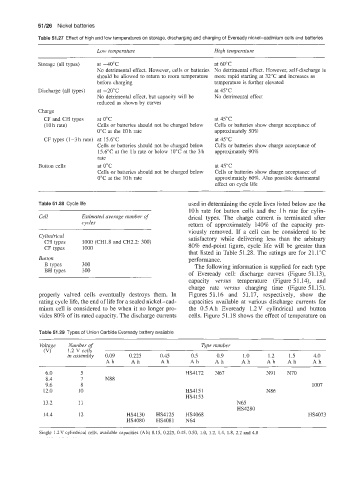Page 588 - Battery Reference Book
P. 588
51/26 Nickel batteries
Table 51.27 Effect of high and low temperatures on storage, discharging and charging of Eveready nickel-cadmium cells and batteries
Low temperature High temperature
Storage (all types) at -40°C at 60°C
No detrimental effect. However, cells or batteries No detrimental effect. However, self-discharge is
should he allowed to return to room temperature more rapid starting at 32°C and increases as
before charging temperature is further elevated
Discharge (all types) at -20°C at 45°C
No detrimental effect, but capacity will be No detrimental effect
reduced as shown by curves
Charge
CF and CH types at 0°C at 45°C
(10h rate) Cells or batteries should not be charged below Cells or batteries show charge acceptance of
0°C at the 10 h rate approximately 50%
CF types (1 -3 h rate) at 15.6"C at 45°C
Cells or batteries should not be charged below Cells or batteries show charge acceptance of
15.6"C at the 1 h rate or below 10°C at the 3 h approximately 90%
rate
Button cells at 0°C at 45°C
Cells or batteries should not be charged below Cells or batteries show charge acceptance of
0°C at the 10 h rate approximately 60%. Also possible detrimental
effect on cycle life
Table 51.28 Cycle life used in determining the cycle lives listed below are the
10 h rate for button cells and the 1 h rate for cylin-
Cell Estimated average number of drical types. The charge current is terminated after
cycles return of approximately 140% of the capacity pre-
viously removed. If a cell can be considered to be
Cylindrical satisfactory while delivering less than the arbitrary
CH types 1000 (CH1.8 and CH2.2: 300)
CF types 1000 80% end-point figure, cycle life will be greater than
that listed in Table 51.28. The ratings are for 21.1"C
Button performance.
B types 300 The following information is supplied for each type
BH types 300
of Eveready cell: discharge curves (Figure 51.13),
capacity versus temperature (Figure 51.14), and
charge rate versus charging time (Figure 51.15).
properly valved cells eventually destroys them. In Figures 51.16 and 51.17, respectively, show the
rating cycle life, the end of life for a sealed nickel-cad- capacities available at various discharge currents for
mium cell is considered to be when it no longer pro- the 0.5Ah Eveready 1.2V cylindrical and button
vides 80% of its rated capacity. The discharge currents cells. Figure 51.18 shows the effect of temperature on
Table 51.29 Types of Union Carbide Eveready battery available
Voltage Number of Type number
(V) 1.2 V cells
in assembly 0.09 0.225 0.45 0.5 0.9 1 .o 1.2 1.5 4.0
Ah Ah Ah Ah Ah Ah Ah Ah Ah
6.0 5 HS4172 N67 N91 N70
8.4 7 N88
9.6 8 1007
12.0 10 HS4151 N86
HS4153
13.2 11 N65
HS4280
14.4 12 HS4130 HS4125 HS4068 HS4073
HS4080 HS4081 N64
Single 1.2V cylindrical cells, available capacities (Ah) 0.15, 0.225, 0.45, 0.50, 1.0, 1.2, 1.4, 1.8, 2.2 and 4.0

